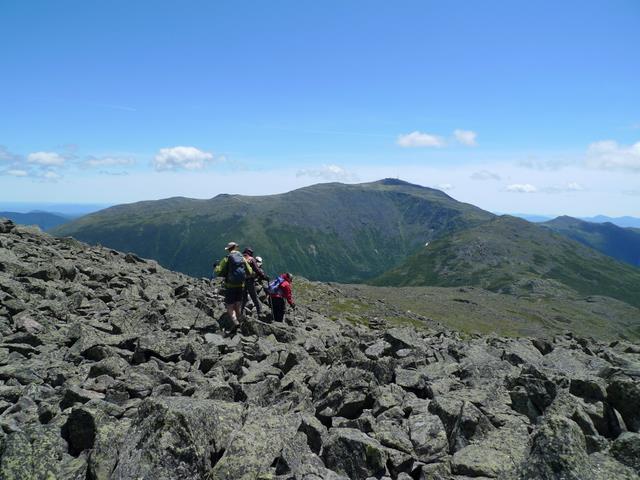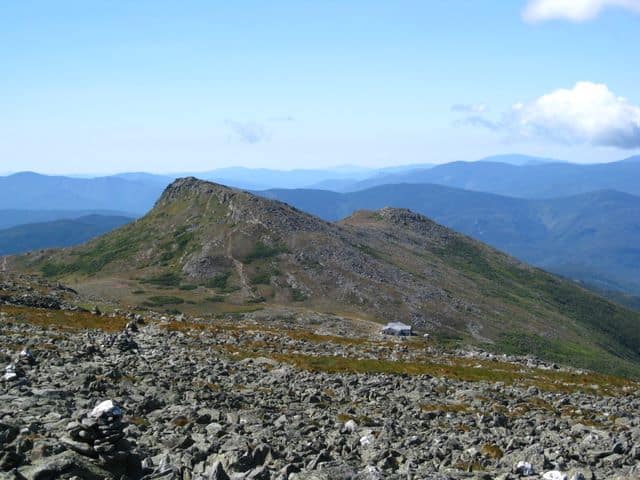Above Treeline. If those words don’t scare you or at least raise your guard, then you should read this post carefully.

Above Treeline occurs at about 4,500 feet of elevation in my neck of the woods, in the White Mountains of New Hampshire. When you get up to this elevation, you are fully exposed to the elements including wind, rain, hail, fog, lightning, snow, and cold. While it can be beautiful in good weather, getting stuck here in fog, a whiteout, or after dark can have lethal consequences, any time of year.
There are no trees and few plants, except lichen and sedge grasses. There’s very little cover if something goes wrong and you may have to wait until daybreak before anyone can come get you in an emergency.
For all practical purposes, it looks like you are on the moon. The tops of the mountains are covered in boulder fields that are tricky to walk on. The rocks are sharp, and if you stumble, it’s easy to cut up your hands when you hit the ground.

Rock cairns replace trail blazes but can be difficult to see in low light, whiteouts, and darkness. Your best defense is good preparation and planning. Bring warm clothing and rain gear (tops and bottoms.) Prepare bail-out routes in advance in case the weather changes suddenly, and remember, there is safety below treeline. When conditions degrade, the people who get below treeline have a higher survival rate.
Despite the harshness of the environment above treeline, it is a very fragile environment that can be easily damaged Don’t pick any flowers or plants above treeline and stay on the path, or jump from rock to rock to avoid disturbing any.
Camping is forbidden above treeline in the White Mountains, except on 2 feet of snow or more. Wood fires are also illegal, so use a backpacking stove (especially since there is no wood above treeline.)

Don’t be afraid to turnaround on a hike above treeline if you run out of daylight or a member of your party becomes fatigued. Most accidents occur at these elevations because someone didn’t turn around until it was too late. Remember, the summit is always optional. Among mountaineers and hikers there is as much glory in a good attempt as there is in a successful summit.
SectionHiker is reader-supported. We only make money if you purchase a product through our affiliate links. Help us continue to test and write unsponsored and independent gear reviews, beginner FAQs, and free hiking guides.See also:
- Garmin inReach Explorer+ Satellite Communicator Review
- Top 10 Beginner GPS Mistakes
- How to Avoid Thunderstorms when Hiking and Backpacking
 SectionHiker.com Backpacking Gear Reviews and FAQs
SectionHiker.com Backpacking Gear Reviews and FAQs
I really enjoyed this blog post and some great information in the comments. I’m a relative novice backpacker with about 6 trips under my belt including Mt.Washington, Mt.Carrigain etc but I’m looking to take my wife and daughter on an overnight backpack. Something under 10 miles roundtrip and some near or above tree line hiking while still being manageable for them would be ideal. Would any of those summit hikes recommended to Rita be suitable as an overnighter?
Moderate and above treeline don’t match. I’d suggest you get a copy of Matt Heid’s, Best Backpacks in New England which has plenty of graded loop hikes in it and probably has something you’re looking for.
Yes..I have that book already..great book..I think we settled on Eisenhower or out and back to Spaulding Lake…
Excellent article filled with extremely good information.
As a solo hiker and backpacker I learned long ago when above Tree-line to focus on taking my time, not allowing extraneous factors compelling me to move along quicker as one does sometimes below Tree-line. As you stated so accurately, when one gets above Tree-line the individual is “fully” exposed.
What brought nostalgia to me was your statement that, “… the tops of the mountains are covered in boulder fields that are tricky to walk on. The rocks are sharp, and if you stumble, it’s easy to cut up your hands when you hit the ground.” Been there, done that! Now with advance age I learn to focus very carefully on my steps and not to worry about getting into a hurry to get out of a bad situation. Take one step at a time, focus and keep moving. I also learned decades ago to fold those “trekking poles,” as they easily can get trapped within crevices of the boulders causing one to lose his or her balance and fall.
Your very last sentence is extremely sage advice that all should take to heart: “…Among mountaineers and hikers there is as much glory in a good attempt as there is in a successful summit.”
Great advice. I was hiking in Utah this past summer and came across conditions as you mentioned
I was not comfortable on going any farther up. My gut told me to go back down and was glad I did. It was a beautiful day and I’m glad it ended that way. Stay safe and god bless.
Out west here, NW Oregon. I hadn’t realized that you can’t camp above timberline there. I love camping above timberline and seek it out. The high Sierras are my favorite for this, followed by the Wind Rivers. In the Northwest most above timberline area is on volcanoes and it’s sometimes hard to find a good level area for a campsite. Not that hard, but there’s more steep than level up there.
Yes, give me the long views and just that feeling of being in someplace out of the ordinary. True that there’s wind, cold, the threat of lightning, and all that, but so far it’s more than worth it. I’ve never been into campfires when backpacking so that part of it is no issue for me.
Loved the article. I have lived in the south central Andean highlands of Peru for almost 18 years. I love hiking in the Andes. Where I go is always about the tree-line, like from 12,000 feet on up to 15,000. Your photos could have been taken in Peru. On a trip I just returned from I learned what a hassle it is to hike up through deep ichu grass. Think hiking through deep snow, deep sand or going up through thick alder brush with a large pack. Check out trekking in the Huayhuash.